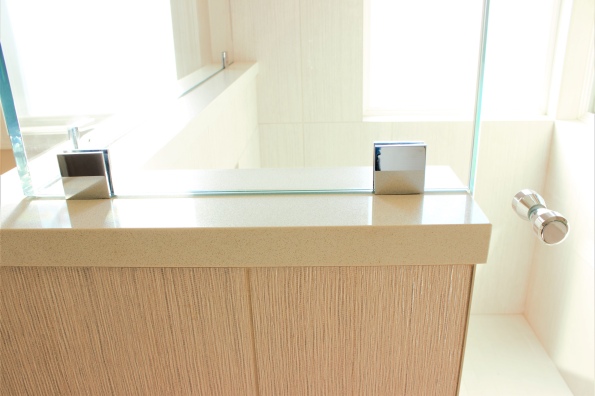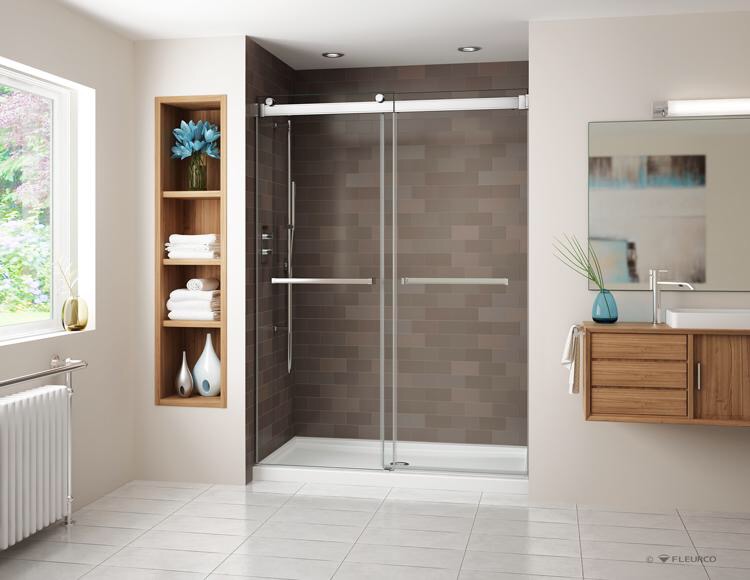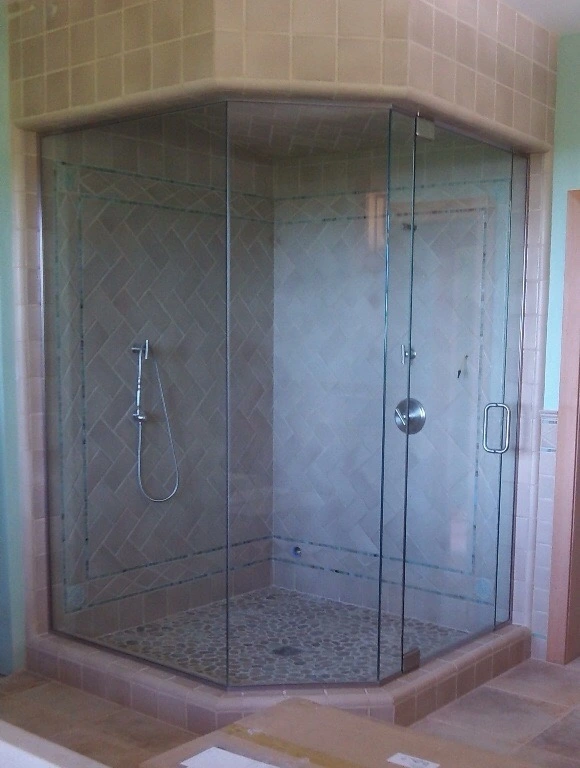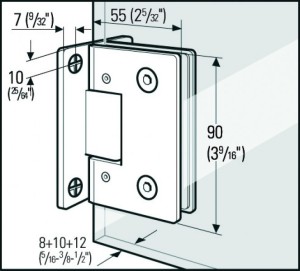Archive
How big is too big when it comes to the gaps…
Chris,
You provide great information in response to questions. I’m hoping you can help me with one I have. We just had a frameless shower installed. All walls are tile, the curb is solid granite. The glass is 1/2 inch with one panel fixed on top of a half wall and the other panel is notched and joins the panel on the wall (90 degree angle) and continues down to the granite curb. It’s a large space so we didn’t need any door. My question is about the notched panel. The tile is square edge but the notch is curved. The glass of the notch rests on the top of the half wall, but where the glass goes down the wall to the granite there is a gap of at least 1/4 inch that the installer filled with silicone. It seems too wide and way too much silicone to me. But I’m not the expert. Your thoughts?
Denise
Hi Denise,
Thanks for your question. How big is too big when it comes to the gaps in your frameless shower enclosure? I’m sure different people will give you different answers… In my opinion, 1/4” is borderline. Generally speaking, we aim to have 1/8” gaps between the glass and the tile. Where the hinge side of the door meets the wall a 1/4” gap is normal. You have the back plate of the hinge, which is 1/8” thick, and the additional 1/8” clearance there. The gap from glass to glass (where the strike side of the door meets the fixed panel at the vertical gap) is normally 3/16”.
It’s important to keep in mind the limitations of the fabricator and the installer. The standard tolerance for frameless shower glass is plus-or-minus 1/8”. This is the industry standard… Although an installer may aim to make all of the joints 3/16” or less, it is not always possible if the glass is not fabricated exactly to specifications. In your case, I would have to say the ¼” gap is acceptable. If it were 3/8” or more I would not be satisfied, but there is little that can be done to prevent what you are describing. After all, it is only 1/16” larger than the ideal.
I hope you find this helpful,
-Chris
Buying Shower Doors and Enclosures Online
More and more people are shopping online these days. It is a convenient way to shop for a lot of different items. People even buy shower doors online, if you can believe it! There are a lot of options available, and some are actually quite good. Showcase Shower Door Company carries a full line of shower doors and enclosures manufactured by Fleurco. They are some of the finest shower enclosures you will find anywhere. We can offer our customers a complete package including the shower pan, glass, hardware, and instructions. All of this delivered right to your front door!

There is the challenge, however, of getting your shower enclosure installed once it arrives. We offer the service of installing customer-supplied shower enclosures for people in our area, whether they buy it from us or not. Wherever it is that you live, there is a good chance that there is a qualified shower enclosure installer available in your area. We here at Showcase Shower Door Company are taking steps to put together a network of quality shower door installers in different parts of the United States. We hope to be able to refer these experts to people who need their services. This will also allow shower enclosure manufacturers who sell their products across the country to take advantage of the skills of qualified installers in every area. Anyway, it’s something we are working on, and I’ll let you know as things develop.
Installing Customer-Supplied Shower Enclosures
We get calls from people who have purchased shower enclosures online and are looking for qualified technicians to install them. In the past, we have made it our policy to avoid installing customer-supplied shower door kits. There are so many different types of enclosures made by various companies… We have found it to be a good idea to just avoid the pitfalls of getting involved with installing them. We have vendors who can supply any type of enclosure that we are not able to manufacture ourselves, so it has made sense to us to install only the doors and enclosures the we sell.
Recently, glass barn door style shower enclosures have become very popular. I first became familiar with these types of enclosures when Cardinal came out with the “Skyline” series enclosure. This was the first frameless sliding enclosure of that type (to the best of my knowledge). It wasn’t long before other manufacturers began to make similar products. It took a while, however, to find any that matched the quality of the Cardinal version.
Today, they are common, and are likely all being made at the same factory overseas… We have started to take orders to install enclosures for people who have purchased them elsewhere, having become so familiar with them. There are other, even more innovative frameless sliding shower enclosures that have come on the market. One such product is the “Essence” series enclosure from C. R. Laurence. It utilizes 1/2″ tempered glass, and has no cross bar at all. This enclosure has become my favorite sliding shower door to install. It’s AWESOME!
For more information, feel free to get in touch.
-Chris
RE: Just One Bracket (?)
Chris,
As shown in the attached picture, our contractor installed our new glass shower panel using only one bracket (along the tiled wall near the top of the panel). A clear adhesive (supposedly “the best material in the business”) was also used along that tiled wall, as well as along the bottom of the panel where it meets a plank tile threshold atop – hopefully – proper shimming).
I can’t find another example of just one bracket being used on anyone’s glass shower panel, anywhere on the internet. Should I be concerned, not just for aesthetics, but also for safety?
Thanks,
Bill
Hi Bill,
We use shower door engineering software from C.R. Laurence to design our enclosures. In order to meet their minimum standard for structural support at the bottom, two brackets or a channel securing the bottom edge are required. I am aware that other shower door companies sometimes use one clamp at the bottom and two clamps on the vertical edge of the glass, but never one single clamp on a panel like the one shown in you photo. This is the first time I have ever seen something like that.
Silicone really is about the best material in the business… I’m guessing that is what was used here? The truth is that the silicone alone probably does have enough strength to keep the panel secure without any other mechanical fasteners. But the only legitimate reason I can see for someone doing it that way would be for looks. It doesn’t sound like you particularly like how it looks, though. I think the most logical explanation for this is that someone forgot the cutouts for the clamps at the bottom of the glass panel, and now they are pretending they meant to do it that way.
Whenever we sell a frameless shower enclosure, we supply a sketch of how it will look when completed. It is a good policy to make the contractor do that for you. Then you can compare the finished product to the sketch and see how close they are to one another. We all make mistakes sometimes. When that happens, it is best to just do the right thing and buy new glass. It never pays off, in the long run, to try cutting corners.
Thanks for writing,
-Chris
“Headerless” Shower Enclosures
Many people who are having frameless shower enclosures installed are looking for the least amount of hardware possible. The challenge to keeping the hardware minimal is greatest when the door hinges from a fixed panel. The stress that is going to be placed on the glass needs to be taken into consideration. When a door hinges from a fixed panel, all of the weight of the door will be supported by the glass, in many cases. There is also the added stress created by the door when it swings in and out, and the initial stress of moving the door past center when the hinges are self-centering.
In many cases, this type of configuration requires additional support at the top of the stationary glass panel. There are a few ways to address this; by using a header, a support bar, or simply extending the height of the fixed panel all the way to the ceiling. The use of top and bottom mounting hinges allow much of the weight of the door to rest on the floor or curb. The top hinge only needs to take the amount of weight required to hold the door upright, and allow for the door to hinge.
By using manufacturer’s recommended clamps, it is possible to hinge a door from a fixed panel without additional support at the top. There are limits to the size and weight of the panels, of course. There have been some great new innovations over the past few years that allow an even more seamless installation then was ever possible before. If you need a frameless shower enclosure, or just have questions, be sure to get in touch… We can help!
Clear Plastic Edge Seals on Frameless Shower Enclosures
Hi Chris,
We are having a frameless shower door installed soon. The installer came to measure the dimensions of the shower, which are 36 x 28 x 36 with the shower door opening in the middle. The installer said that we have to have a header on the top because the door opens in the middle. From what we have been reading this is correct. Our main concern is that he said that we have to have plastic stripping down each of the side panels and at the opening between the door and glass panel.
We were really excited to have a frameless door and now it seems like these plastic strips down all of the panels will be a detraction. We have been reading that silicone can be used if leaking in this small shower would be a concern.
Our question to you is, should we let him put in the plastic strips? We went from being excited about having this glass door installed to dreading these unsightly glass walls with plastic strips?
Thanks,
Diane and Keith
Dear Diane and Keith,
Thanks for the question. I am in agreement with you about the plastic strips (edge seals). Although they are available in clear poly-carbonate, and blend in fairly well, I always try to avoid them. As you point out in your note, they do detract from the beauty of the shower enclosure. There are, of course, certain instances where they are unavoidable, but this is rare.
The most important thing to keep in mind about frameless shower enclosures is the fact that they are NOT watertight. They are not meant to be. This is a topic I cover in my blog regularly… here are two articles from last year where I talk about this:
If your installer is going to try to make your frameless shower enclosure hold water by adding plastic seals to the glass, he is fighting a losing battle! There is the temptation to sell the most expensive product to a customer (for obvious reasons) regardless of whether it is the right solution for their particular situation. It is sad, but it does happen. If you need a shower door that is water tight, don’t buy a frameless one. You will be sorry! Wait until you have a bathroom that is suitable for a frameless enclosure before you install one. Your shower door salesperson should know the difference.
Thanks for reading my blog!
-Chris
Seals in Steam Shower Enclosures
The frameless door in my steam shower is supposed to go to the ceiling. It was installed with a plastic edging that causes the door to scrape the ceiling so hard the paint comes off. I took off the plastic edging but there is now a gap at the top of the door. Is this normal? How should it have been done?
Virginia
Hi Virginia,
When people get a new steam shower they often think that the enclosure needs to be air-tight. Not only is this untrue, it is a bad idea. While it is obvious that you want to trap the steam inside of the shower so you can enjoy the hot, steamy goodness of it all, it isn’t necessary to become obsessed with the tiniest bit of steam escaping. Only you can decide if enough of the steam is staying in the shower.
It is always a challenge to keep the maximum amount of steam in while making the door operate correctly. It sounds like, in your case, it required removing one of the seals. You have to decide if the steam shower is functioning the way you think it should without it. If you feel that too much steam is escaping, it may be possible to attach an edge seal to the ceiling of the shower, rather than the glass. Sometimes that is a solution…
Let me know how things work out, OK?
Chris
RE: Glass Shower Doors and Surface Treatments
Hello,
I happened upon your blog and am very impressed with the wealth of information there!
I just had a new shower enclosure (corner) put in, and am wondering whether it is necessary to treat the glass with some kind of sealant. The prior glass would get cloudy pretty quickly (I’m not sure whether our water is “hard”, or it was soap residue) and I found myself cleaning it every week, which was sometimes difficult to do since the only way I could get it really clean was to use a scour pad (non-scratch, of course!).
I saw on your blog that you recommend the “Liquid Diamond” product, but am not sure which one to order for my needs. Can you help? And, can you tell me whether this product needs to be reapplied, or how it is maintained?
Thank you so much for your time! (I am located in New York City).
Miriam
Hi Miriam,
It’s a good idea to use some type of product to protect your shower glass. Nothing will prevent water spots from forming on glass, but you can prevent water stains from ruining your shower door. There are a couple of different options available. You can purchase “Rain-X” or a similar product and apply it yourself. My experience is that this type of product needs to be reapplied every few months. The great thing about the Liquid Diamonds product from Diamond Seal Systems is that it doesn’t require regular applications. The maintenance is pretty simple, and primarily consists of refraining from using harsh cleaners. If properly cared for, the Diamond Seal treatment will never need to be reapplied. There is probably a certified installer in your area.
Thanks for reading the blog,
Chris Phillips – Owner
Showcase Shower Door – CCL #957120
1970 17th Avenue #C – Santa Cruz, CA 95062
Phone: (831) 464-3899 – FAX: (831) 477-0760
RE: Shower Door Question – Frameless Door Hinges
Chris,
I have a frameless shower door that swings freely in both directions. There is no catch and no sweep on the bottom of the door. For the first several years after installation the door would always return to rest at an exactly centered position when closed. If moved an inch or two in one direction or the other, the door would always return to exact center. Over the past several months the door began to no longer rest in a centered position. Instead, the door has it begun to rest in a slightly open position. The gap is getting larger as time goes on. Now the door is resting in a position leaving a gap of an inch or so between the door and the adjacent glass panel. Any idea what might be causing this? Is there something I can do to adjust the door or the hinges so the door will once again rest in a centered position? I’ll call a glass company for a service call if necessary but if there is something simple I can do I’d rather try that first.
I appreciate any assistance.
Thank you,
Brian
Hi Brian,
Most likely, your hinges are suffering from soap build-up, or are just wearing out. Frameless shower door hinges come with a three-year warranty. The manufacturers of these hinges don’t recommend using any kind of lubrication on them. Since they are out of warranty anyway, you may want to consider trying some type of lube and see if it helps. I would go with a silicone spray rather than WD-40… I think you will get better results that way. If all else fails, you can have the hinges replaced, but that won’t be cheap. It sounds like your hinges are still working, just not self-centering the way that they used to.
Let me know how things work out,
-Chris
Help.
Hi Chris:
I was so happy to see your website and was wondering if u can give me any advice. I have a fixed shower panel where it is secured at the bottom with U Track type of metal. My contractor guys forgot to seal it in the beginning so water got in and leaked outside. After I informed them of the problem they came back and put clear silicon seal around the bottom. Everything was good for about 6 months. And now I’m noticing black stuff (I’m assuming it’s some kind of mold) inside the silicon seal and INSIDE the track! Is there any way I can clean it out? and after cleaning it out (hopefully) how do i seal again? Is silicon caulking enough? or is there any kind of seal strip i should add?
thank you very much for your help!
Charlotte
Hi Charlotte,
Thanks for reading my blog. It looks like the caulking was applied after the water was already in the channel. Once the mold began to grow, it was trapped inside. Since the glass is clear, the mold is highly visible… In order to fix the problem, the glass is going to need to be removed from the channel. I would clean it thoroughly, and use bleach to make sure that the mold is completely eliminated. Only then should the glass be replaced, and the silicone seal reapplied. Make sure that the glass and channel are nice and dry before you do so. There is also a type of silicone that is “mildew resistant.” This is the type you are going to want to use. It has a fungicide in the formula, and will help to prevent the mold growth. Apply the silicone where the metal and glass meet to prevent water from entering the channel.
Best wishes,
-Chris


